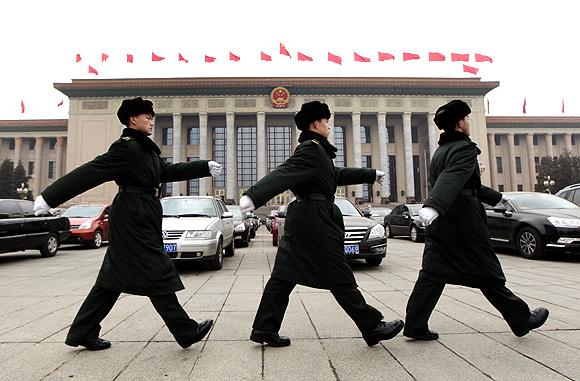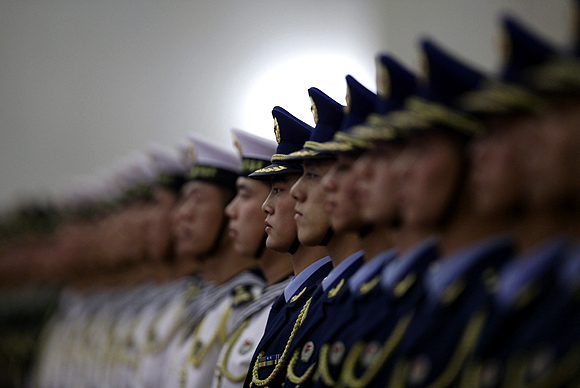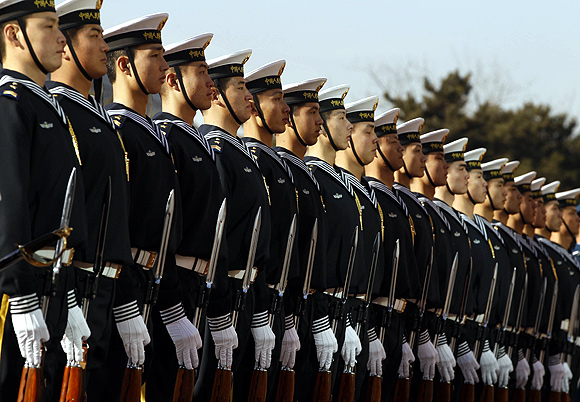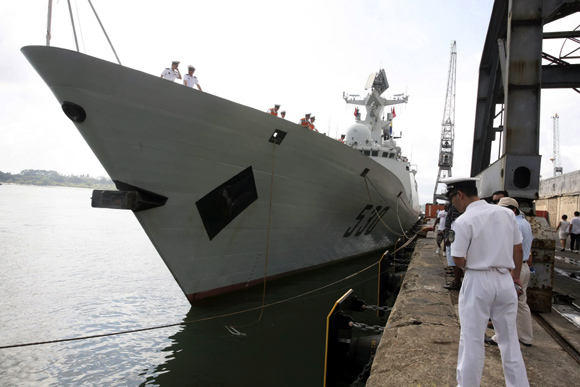 |
This year China has again announced a double-digit increase in its military spending, as concerns continue to rise in the region and beyond about China's true intentions behind its building of capabilities.
Last week, Beijing announced that the total defence budget for 2012 would be increased to $106 billion, from $95.6 billion last year, an increase of 11.2 per cent. And this is when vital elements of the Chinese military build-up, including cyberwarfare and space capabilities (as well as foreign procurement) were not included in the announced budget.
The bulk of the increased defence spending will go to the Chinese navy, air force and the Second Artillery Corps -- which runs the strategic nuclear forces.
The spokesman of the National People's Congress, who announced the military budget, suggested that the military spending increase was in line with Chinese economic development and as a percentage of gross domestic product compared with other countries, specifically the United States and Britain, the increase was relatively low.
The spokesman of the National People's Congress, who announced the military budget, suggested that the military spending increase was in line with Chinese economic development and as a percentage of gross domestic product compared with other countries, specifically the United States and Britain, the increase was relatively low.
US has initiated its foreign policy pivot towards Asia
 |
What has been causing concern in Asia and beyond is the opacity that seems to surround China's military build-up, with an emerging consensus that Beijing's real military spending is at least double the announced figure. Just last year, it has been estimated that China ended up spending $160 billion instead of the announced $95.6 billion!
This year's dramatic rise comes at a time when the US has initiated its foreign policy pivot towards Asia. As the US secretary of state has already underlined, "the future of politics will be decided in Asia, not Afghanistan or Iraq, and the United States will be right at the centre of the action."
This year's dramatic rise comes at a time when the US has initiated its foreign policy pivot towards Asia. As the US secretary of state has already underlined, "the future of politics will be decided in Asia, not Afghanistan or Iraq, and the United States will be right at the centre of the action."
At a time when talk of American decline and retrenchment from global commitments has become de rigueur, the signals coming from Washington are that it has no intention of leaving the Asian strategic landscape.
Nor will regional states allow America to lower its profile. After all, the elephant in the room, or region, is China's faster-than-expected ascent in the global inter-state hierarchy.
Emerging threat from China's massive military build-up
 |
The new defence strategy outlined by Washington recently is explicitly geared towards tackling the emerging threat from China's massive and rapid military build-up. It takes forward the process already-underway, of reorienting the American military might from the Atlantic to the Pacific.
With his visit to Asia last November and with a new military strategy that focuses on the region, the Obama administration is underscoring America's commitment to regional stability at a time when the US is wrapping up two wars in Iraq and Afghanistan. This new strategy is unambiguous in underlining the challenge in the Asia-Pacific and turning America's gaze Asia-ward.
With his visit to Asia last November and with a new military strategy that focuses on the region, the Obama administration is underscoring America's commitment to regional stability at a time when the US is wrapping up two wars in Iraq and Afghanistan. This new strategy is unambiguous in underlining the challenge in the Asia-Pacific and turning America's gaze Asia-ward.
"As I made clear in Australia, we will be strengthening our presence in the Asia-Pacific, and budget reductions will not come at the expense of this critical region," Obama remarked at the Pentagon while releasing the new strategy.
It remains to be seen how successful this strategy will be in meeting the challenges of the future, but it should give some respite to regional states, including India, which are confronted with a rapidly rising China and all its attendant consequences.
China remains very sensitive
 |
As America's economic constraints force it to go back to an "offshore balancing" posture, it needs new arrangements in Asia if it wants to prevent China from dominating the regional strategic landscape.
The US will increasingly rely on its regional allies and regional arrangements to carry more of the security burden, much as it did via its hub-and-spokes alliance system in Europe since the end of the Second World War.
China, of course, remains very sensitive to this more pro-active approach in Asia and has suggested that a "Cold War mentality" is not the way forward; but the regional states have their own plans.
Concerns remain that, while the US is ostensibly shifting its strategic focus on Asia, it is decreasing its military strength in the region, leading to an inevitable power vacuum in East Asia and the Pacific which China may be determined to fill.
Beijing has raised questions
 |
The US has encouraged a greater role for India in East and Southeast Asia. Exhorting India to lead and look beyond its immediate neighbourhood, Secretary of State Hillary Clinton during her visit to India earlier this year asked India "not just to look east, but to engage east and act east as well."
India has responded with a renewed focus on its Look East policy, which has evolved from economic and trade linkages with various regional countries to a gradual strengthening of security ties.
India's ties with Japan, in particular, have been gaining momentum, with both New Delhi and Tokyo making an effort in recent years to put Indo-Japanese ties into high gear. India's role in East and Southeast Asia is only likely to grow in the future as China's faster-than-expected economic and military rise forces New Delhi to reorder its strategic priorities.
Beijing's rapidly rising defence expenditure; its expansive maritime sovereignty claims; its aggressive behaviour pursuing them; its support for states such as North Korea and Pakistan; and its non-transparent military build-up all raise questions about its willingness to act as a responsible stakeholder in the region. How to manage China's rise and mould its behaviour will be one of the biggest diplomatic challenges facing the region and the world in the coming years.
Beijing's rapidly rising defence expenditure; its expansive maritime sovereignty claims; its aggressive behaviour pursuing them; its support for states such as North Korea and Pakistan; and its non-transparent military build-up all raise questions about its willingness to act as a responsible stakeholder in the region. How to manage China's rise and mould its behaviour will be one of the biggest diplomatic challenges facing the region and the world in the coming years.
source:reddifnews


0 comments:
Post a Comment